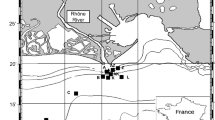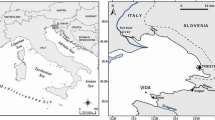Abstract
Purpose
In summer 2007, biweekly benthic fluxes of the biogenic elements carbon (C), nitrogen (N), silicon (Si), and phosphorus (P) were studied in the Sečovlje saltern (salt-making facility) in the northern Adriatic Sea, Slovenia in order to determine the impact of stromatolite (“petola”) on the geochemical properties of saltern sediments.
Materials and methods
The brine and pore waters were analyzed for salinity, NH +4 , NO −3 , PO 3−4 , SiO 4−4 , total dissolved nitrogen, total dissolved phosphorus, and fluorescent dissolved organic matter. The sediment was analyzed for organic carbon (OC), total nitrogen (TN), total and organic phosphorus (OP), and biogenic Si concentrations, as well as values of δ 13COC and δ 15NTN.
Results and discussion
Nutrient concentrations in brine water increased along the salinity gradient due to different processes, such as the evaporative concentrations of seawater, bacterial activity, more pronounced transformation and degradation of organic matter, and regeneration of nutrients. The petola from the Sečovlje saltern, which is predominately composed of cyanobacterial and diatom communities, develops during the early evaporation stage and survives during high salinity and halite crystallization. Nitrogen fixation and P removal were the principal biogeochemical processes controlling dissolved inorganic N and P concentrations. At higher salinities, N limitation was more important. Microbes decomposed at higher salinities, and the remineralized N and P nutrients were released from surface pore waters to the brine. OP remineralization was also an important process influencing the distribution of PO 3−4 concentrations in pore waters deeper in the sediments. The increasing SiO 4−4 concentrations with increasing salinity in the brine waters were due to dissolution of diatom frustules, while the decrease in pore water SiO 4−4 was probably the consequence of microbial uptake.
Conclusions
This study provides a better understanding of nutrient cycling and the geochemical processes in the Sečovlje saltern.


Similar content being viewed by others
References
Aspila KI, Agemian H, Chau ASY (1976) A semi-automatic method for the determination of inorganic, organic and total phosphate in sediments. Analyst 101:187–197
Benning L, Phoenix VR, Yee N, Konhauser KO (2004a) The dynamics of cyanobacteria silicification: an infrared micro-spectroscopic investigation. Geochim Cosmochim Acta 68:729–741
Benning L, Phoenix VR, Yee N, Tobin MJ (2004b) Molecular characterization of cyanobacterial silicification using synchrotron infrared micro-spectroscopy. Geochim Cosmochim Acta 68:743–757
Bidl KD, Azam F (2001) Bacterial control of silicon regeneration from diatom detritus: significance of bacterial ectohydrolases and species identity. Limnol Oceanogr 46:1606–1623
Boudreau BP (1996) The diffusive tortuosity of fine-grained unlithifield sediments. Geochim Cosmochim Acta 60:3139–3142
Bruce LC, Imberger J (2009) The role of zooplankton in the ecological succession of plankton and benthic algae across a salinity gradient in the Shark Bay solar salt ponds. Hydrobiol 626:111–128
Butinar L, Sonjak S, Zalar P, Plemenitaš A, Gunde-Cimerman N (2005a) Melanized halophilic fungi are eukaryotic members of microbial communities in hypersaline waters of solar salterns. Bot Mar 48:73–79
Butinar L, Santos S, Spencer-Martins I, Oren A, Gunde-Cimerman N (2005b) Yeast diversity in hypersaline habitats. FEMS Microbiol Lett 244:229–234
Canfield DE, Thamdrup B, Kristensen E (2005) Aquatic geomicrobiology. Adv Mar Biol 48:427–431
Casillas-Martinez L, Gonzales ML, Fuentes-Figueroa Z, Castro CM, Nieves-Mendez D, Hernandez C, Ramırez W, Sytsma RE, Perez-Jimenez J, Visscher PT (2005) Community structure, geochemical characteristics and mineralogy of a hypersaline microbial mat, Cabo Rojo, PR. Geomicrobiol J 22:269–281
Coleman MU, White MA (1993) The role of biological disturbances in the production of solar salt. Seventh Symp Salt 1:623–631
De Master DJ (1981) The supply and accumulation of silica in the marine environment. Geochim Cosmochim Acta 45:1715–1732
Faganeli J, Pezdič J, Ogorelec B, Dolenec T, Čermelj B (1999) Salt works of Sečovlje (Gulf of Trieste, northern Adriatic)—a sedimentological and biogeochemical laboratory for evaporitic environments. RMZ-Mater Geoenviron 46:491–499
Giordano M, Beardall J (2006) Impact of environmental conditions on photosynthesis, growth and carbon allocation strategies of hypersaline species of Dunaliella. In Lekkas TD, Korovessis NA (eds) Proc. 1st Int Conf on the Ecological Importance of Solar Saltworks (CEISSA 06), Santorini Island, Greece, 20–22 October 2006, pp. 65–71
Grasshoff PN, Ehrhardt M, Kremling K (1983) Methods of seawater analysis. Verlag Chemie, Weiheim
Gunde-Cimerman N, Plemenitaš A (2006) Ecology and molecular adaptations of the halophilic black yeast Hortaea werneckii. Rev Environ Sci Biotechnol 5:323–331
Gunde-Cimerman N, Zalar P, De Hoog GS, Plemenitaš A (2000) Hypersaline waters in salterns: natural ecological niches for halophilic black yeasts. FEMS Microbiol Ecol 32:235–240
Huon S, Grousset FE, Burdloff D, Bardoux G, Mariotti A (2002) Sources of fine-sized OM in North Atlantic Heinrich Layers: δ 13C and δ 15N tracers. Geochim Cosmochim Acta 66:223–239
Javor B (1989) Hypersaline environments - microbiology and biogeochemistry. Springer Verlag, Berlin, p 328
Joint I, Henriksen P, Garde K, Riemann B (2002) Primary production, nutrient assimilation and microzooplankton grazing along a salinity gradient. FEMS Microbiol Ecol 39:245–257
Knoppers B, Landim de Souza WF, Landim de Souza MF, Rodriguez EG, da Cunha Viana Landim EF, Vieira AR (1996) In situ measurements of benthic primary production, respiration and nutrient fluxes in a hypersaline coastal lagoon of SE Brazil. Rev Bras Oceanogr 44:155–165
Kovač N (2009) Chemical characterization of stromatolitic ‘petola’ layer (Sečovlje salt-pans, Slovenia) using FT-IR spectroscopy. Ann Ser Hist Nat 19:1–8
Krom MD, Berner RA (1980) The diffusion coefficients of sulfate, ammonium and phosphate ions in anoxic marine sediments. Limnol Oceanogr 25:327–337
Ladakis M, Dassenakis M, Pantazidou A (2006) Nitrogen and phosphorus in coastal sediments covered by cyanobacteria mats. J Soil Sci 6:46–54
Lerman A (1979) Geochemical processes water and sediment environments. Wiley, New York
Levine SN, Schindler DW (1992) Modification of the N:P ratio in lakes by in situ processes. Limnol Oceanogr 37:917–935
Ludwig R, Pringault O, de Wit R, de Beer D, Jonkers HM (2006) Limitation of oxygenic photosynthesis and oxygen consumption by phosphate and organic nitrogen in a hypersaline microbial mat: a microsensor study. FEMS Microbiol Ecol 57:9–17
Meyers PA (1994) Preservation of elemental and isotopic source identification of sedimentary organic matter. Chem Geol 114:289–302
Ogorelec B, Mišič M, Faganeli J (1991) Marine geology of the Gulf of Trieste (northern Adriatic): sedimentological aspects. Mar Geol 99:79–92
Ogorelec B, Mišič M, Faganeli J (2000) Sečoveljske soline—geološki laboratorij v naravi. Ann Ser Hist Nat 10:243–252
Ogrinc N, Faganeli J (2006) Phosphorous regeneration and burial in near-shore marine sediments (the Gulf of Trieste, northern Adriatic Sea). Estuar Coast Shelf Sci 67:579–588
Ogrinc N, Fontolan G, Faganeli J, Covelli S (2005) Carbon and nitrogen isotope composition of organic matter in coastal marine sediments (the Gulf of Trieste, N Adriatic Sea): indicators of sources and preservation. Mar Chem 95:163–181
Oren A (1999) Bioenergetic aspects of halophilism. Microbiol Mol Biol Rev 63:334–348
Oren A (2001) The bioenergetic basis for the decrease in metabolic diversity in increasing salt concentrations: implications for the functioning of salt lake ecosystems. Hydrobiol 466:61–72
Oren A (2009) Saltern evaporation ponds as model systems for the study of primary production processes under hypersaline conditions. Aquat Microb Ecol 56:193–204
Pantoja S, Repeta J, Sachs JP, Sigman DM (2002) Stable isotope constraints on the nitrogen cycle of the Mediterranean Sea water column. Deep-Sea Res I 49:1609–1621
Pašić L, Galan Bartual SG, Poklar Ulrih N, Grabnar M, Herzog Velikonja B (2005) Diversity of halophilic archaea in the crystallizers of an Adriatic solar saltern. FEMS Microbiol Ecol 54:491–498
Pašić L, Poklar Ulrih N, Černigoj M, Grabnar M, Herzog Velikonja B (2007) Haloarchaeal communities in the crystallizers of two Adriatic solar salterns. Can J Microbiol 53:8–18
Pedrós-Alió C, Calderón-Paz JI, MacLean MH, Medina G, Marrasé C, Gasol JM, Guixa-Boixereu N (2000) The microbial food web along salinity gradients. FEMS Microbiol Ecol 32:143–155
Schneider J (1979) Stromatolithic Milieus in Salinen der Nord-Adria (Sečovlje, Portorož, Jugoslawien). In: Krumbein W (ed) Oldenburger Symposium über Cyanobakterien, 1977,—Taxonomische Stellung und Ökologie. Universität Oldenburg, Oldenburg, pp 93–106
Schneider J, Herrmann GA (1979) Saltworks—natural laboratories for microbiological and geochemical investigations during the evaporation of seawater. In: Coogan AH, Hauder L (eds) Fifth international symposium on salt. Northern Ohio Geological Society, Cleveland, pp 371–381
Skoog A, Hall PO, Hulth S, Paxeus N, Rutgers van der Loeff M, Westerlund S (1996) Early diagenetic reduction and sediment–water exchange of fluorescent dissolved organic matter in coastal environment. Geochim Cosmochim Acta 60:3619–3629
Stiller M, Nissenbaum A (1999) Geochemical investigation of phosphorus and nitrogen in the hypersaline Dead Sea. Geochim Cosmochim Acta 63:3467–3475
Tkavc R, Gostinčar C, Turk M, Visscher PT, Oren A, Gunde-Cimerman N (2010) Bacterial communities in the ‘petola’ microbial mat from the Sečovlje salterns (Slovenia). FEMS Microbiol Ecol 75:48–62
Wollast R, Garrels RM (1971) Diffusion coefficient of silica in seawater. Nature 229:94–96
Zalar P, Kocuvan M, Plemenitaš A, Gunde-Cimerman N (2005) Halophilic black yeast colonize wood immersed in hypersaline water. Bot Mar 48:323–326
Author information
Authors and Affiliations
Corresponding author
Additional information
Responsible editor: Geraldene Wharton
Electronic supplementary material
Below is the link to the electronic supplementary material.
ESM 1
(DOC 1083 kb)
Rights and permissions
About this article
Cite this article
Škrinjar, P., Faganeli, J. & Ogrinc, N. The role of stromatolites in explaining patterns of carbon, nitrogen, phosphorus, and silicon in the Sečovlje saltern evaporation ponds (northern Adriatic Sea). J Soils Sediments 12, 1641–1648 (2012). https://doi.org/10.1007/s11368-012-0605-y
Received:
Accepted:
Published:
Issue Date:
DOI: https://doi.org/10.1007/s11368-012-0605-y




